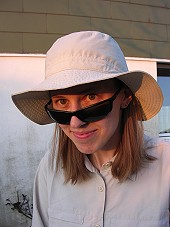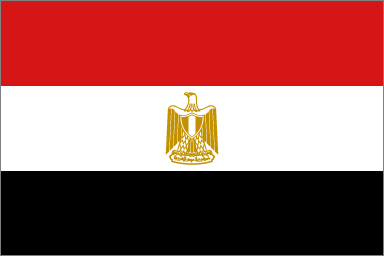
MARTINA'S WORLD TRIP
EGYPT: April 25 - May 18, 2004


(Übersetzungshilfe)
 |
MARTINA'S WORLD TRIP EGYPT: April 25 - May 18, 2004 |
|||||||
 |
||||||||
 |
Your Dictionary
(Übersetzungshilfe) |
|||||||
| Monday, May 3rd, 2004 - Luxor / Hurghada | |||||||
| Monday, May 3rd, 2004 - Luxor / Hurghada
Getting up at 5 am was tough this morning but we had a very interesting programme scheduled for the day, starting with a donkey ride to the Valley of the Kings where most Egyptian pharaohs are burried in their amazing tombs. We first had to take a boat to the West Bank of the Nile where we met our donkey herd. Each of us was assigned a suitable donkey according to our size and got a quick brief how to manage it. Whoever tried to navigate a donkey knows that it is nothing like riding a horse... Not only is a donkey much smaller in size and less comfortable but also so much more stubborn! I remember an outdoor training we had with EMDS in Belgium where we had to do a "donkey race". 4 people got one donkey: one person to ride it, one to push, one to pull and one to steer - it was incredible!! Well, this time I was more lucky. My donkey was a white medium-sized cute fellow, named "Mishlawa". He went quite well and followed my guiding. The ride took about 45 minutes, mainly spent in a quick donkey walk which makes you pretty much bump up and down. We could feel the ride in our butts for the next 2 days! Nevertheless, it was a lot of fun and - oh what a surprise - I did enjoy it! When we arrived at the Valley of the Kings it was still early but already full of tourists. We got a ticket to visit 3 tombs, the ones of Ramses III, IV, V and VI (they've got one together since the son decided to kick his father out and use the same tomb). With an extra ticket it was possible to visit the tomb of Tutankhamun which I did. This visit was actually the most disappointing because his grave is super small and badly preserved. Due to the spectacular discovery of his tomb by Howrad Carter in 1922, Tutank-hamun seems to be one of the most famous pharaohs, although he reigned for only 9 years without any special achievements and died very young. Nevertheless, his tomb was the only one discovered intact with loads of treasures that are nowadays exposed in the Egyptian museum in Cairo, including his famous golden mask. Still, the extra ticket wasn't worth it. The best tomb was the first one we saw (Ramses IV) which has been opened not very long ago. It was a bit smaller than the ones of the other Ramses' but very well preserved. Basically, what you see (in all 3 tombs we've visited) is a long white corridor that is over and over decorated with colourful hieroglyphics. The ceiling as well is painted and larger wall pictures include different ancient gods and the glorious pharaoh during his life time. The largest tomb (of Ramses III) was 125 m long before you reached the burial chamber at the end! Some tombs include more than one hallway with smaller chambers, alleys and arches on the way, all painted, decorated and surprisingly colourful. At the end, there's the burial chamber that once contained the sarcopahgus. Most of them are not there anymore but you could see the stone altar on which they were presented originally. Overall, a very amazing place this Valley of the Kings, especially if you imagine how they were built thousands of years ago! Our guide told us that the workers actually used huge metal shields as mirrors to channel the daylight deep into the tombs as no artificial light was known at that time. After our tomb visits we crossed "Magic Mountain" to get on the other side. This was quite a steep hike of about 1 hour or a little more. Don't forget about the local temperature which I measured and it was 45 degrees in the sun today! I took it slow, just as I like it (you guys in Asturias know what I mean!) and basically walked with Sarah, the oldest of our group, and Alyson who calls herself a "city chick", so none of us was a big hiker. Still we made it and were proud of us! On the other side of the mountain we visited "Deir al-Bahri", the Temple of Hatshepsut. Hatshepsut was the most famous female pharaoh (yes, there were females as well!) and reigned 1473 - 1458 BC. Being the daugther of Tuthmosis I, Hatshepsut was married to her half-brother Tuthmosis II (totally normal at that time), whose son by a minor wife was to be his successor. As Tuthmosis III was still very young when his father died. Hatshepsut was made regent. With the political support of the Amun priesthood, she ruled as pharaoh for 20 years, and for Egypt it was a time of peace and internal growth. Her funerary temple is partly rock-cut into the natural cliff of the mountain and partly freestanding. Hatshepsut herself is shown in the reliefs sometimes as male figure with a false beard while in other scenes she is clearly female. Quite an interesting place to visit. In the afternoon it was still 34 degrees in the shade when we took a taxi to the Colossi of Memnon statues. Rising 18 meters high, experts reckon that the statues are the only remains of a huge temple complex built by Amenhotep III as his funerary temple which supposedly covered a larger area than Karnak. The reason for the temple's complete disappearance is that it sat on the flood plain of the Nile and the annual inundation of water has eroded away almost all traces of the building over the centuries. We had lunch at an African restaurant on the West Bank before returning to the hotel to pack up our bags. It has to be said that I still didn't feel very well with my stomach being a little upset, but I was much better off than a few others of our group who had serious problems with "Ramses' revenge"... The bus ride to Hurghada took about 3 hours - which I spent almost entirely sleeping. It was unbelievable, already on the way to Abu Simbel I slept like a stone, although I initially wanted to watch the landscape. Today the same thing happened - hardly on the bus, I was sound asleep. The little bit I saw of the landscape was pretty much deserted: dusty rocks and stones everywhere, here and there a few dry bushes, but no more life than that. I really couldn't help but wonder (as Carrie Bradshaw would say): How could people manage to survive in a country like that??? In Hurghada we went for dinner at a very nice Italian restaurant. Hurghada itself is not big but VERY touristic, so that it has lost most of its Arabic origin. Unfortunately, being a popular tourist destination, this place has also pretty much caught up with European prices and was much more expensive than what we were used to so far. After dinner, I went to an internet cafe to continue my diary, and then did some shopping for the bus tour tomorrow. Overvall, this day was long: I was in bed at 00:15... |
|||||||